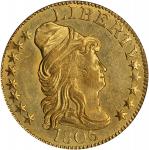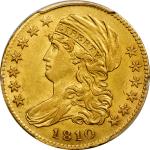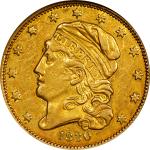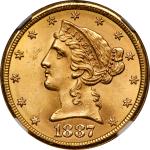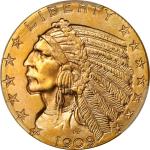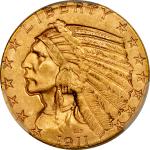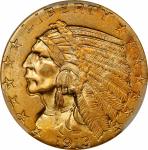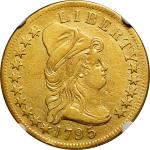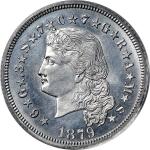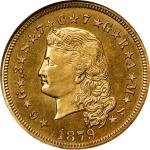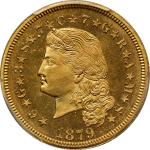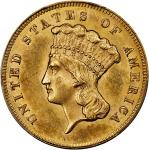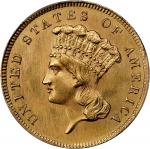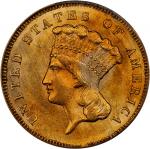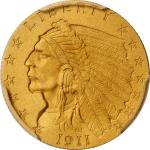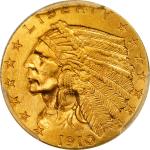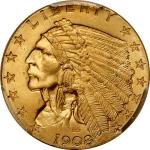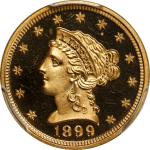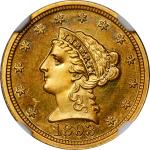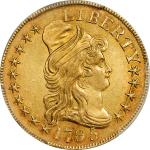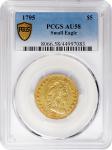1795 Capped Bust Right Half Eagle. Small Eagle. BD-1. Rarity-5. AU-58 (PCGS).A sharply struck, near-fully lustrous example of this significant first year gold issue from the United States Mint. The texture is soft and satiny with subtle semi-reflective tendencies evident in the fields as the surfaces dip into a light. Attractively original, blushes of pale rose peripheral iridescence blend with dominant color in deep olive and orange-gold. Wispy handling marks are mentioned solely for accuracy, and in the absence of sizeable blemishes this coin presents as exceptionally smooth in hand. It is a superior example of the type, issue and die pairing that is worthy of the strongest bids. BD Die State c/b.<p>As with the larger $10 eagle, the $5 half eagle was authorized by the Act of April 2, 1792, that established the United States Mint and defined the nations monetary system. These earliest gold coins do not include an expression of the denomination as part of the design, a curious feature for someone familiar only with modern U.S. coinage. This was no oversight, however, as these denominations were stated by law in the aforementioned 1792 Act. Section 20 states "That the money of account of the United States shall be expressed in dollars or units, dismes or tenths...." Naturally, the value of gold to silver was also set forth in this Act. The Act defined the ratio of pure silver to gold as 15 parts to one being of equal value. Therefore, the relative denominations were consistent fractions, tenths or related logical fractions of the "unit" or dollar measure of silver or gold. Merchants always weighed coins in transactions, and their values were determined by experience and the trustworthiness of the money issuer. A gold half eagle would be understood to contain the proper ratio of gold to silver, being worth five silver dollars or units. Clearly the young United States of America had to prove sound coinage on an international, as well as local front.<p>The Act of 1792 also stated "That the said assayer, chief coiner and treasurer" of the Mint each had to be bonded to the United States of America for $10,000 with the condition for the faithful and diligent performance of the duties of their respective office. A $10,000 bond was a staggering amount of money at the time. It was only after a reduction in the bond requirement and the help of sureties, that the beginning of gold coinage was achieved in July 1795 with the delivery of the first half eagles. Ten-dollar eagle coinage began in September of that year.<p>The Capped Bust Right half eagle and eagle are both the work of Robert Scot, who became engraver at the Philadelphia Mint after Joseph Wright died in one of the annual yellow fever epidemics. Scots device punch for Libertys portrait was used to create new dies as they were needed. He is also believed to have created the delicate "small eagle" hub punch for the reverse.<p>Mint records state that 8,707 half eagles were struck in 1795. The first delivery took place on July 31, 1795, to the extent of 744 pieces. Most numismatic scholars believe that these initial examples were struck from the die pairing that we now know as BD-1. This might seem improbable given that both the obverse and reverse dies were rusted at the time of striking, suggesting that they sat idle for quite some time before being pressed into service. Evidence of this rust is seen on the present coin in the lower left field around the date and stars 1 to 3, at the upper right reverse border after the word OF, and in other places. Modern numismatic scholarship suggests that the delay in production of this variety was not due to the Mints initial use of other dies, but rather the general delay in striking the first gold coins while its employees struggled to post the $10,000 bonds that Congress required before they could handle deposits of this precious metal.<p>John W. Dannreuther (<em>Early U.S. Gold Coin Varieties: A Study of Die States, 1795-1834</em>, 2006) believes that additional deliveries from this die pairing occurred after July 31, for an estimated mintage of 750 to 1,500 coins for the 1795 BD-1 half eagle. Survivors are elusive, as is the case for all pre-1834 U.S. gold coin issues, with the author accounting for only 40 to 50 pieces in all grades.PCGS# 8066. NGC ID: 25ND.From our sale of the Andrew M. Hain Collection, Spring 2022 Auction, April, lot 3125.

